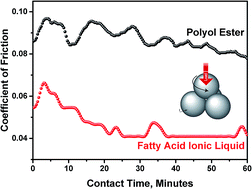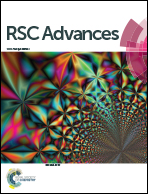Fatty acid ionic liquids as environmentally friendly lubricants for low friction and wear†
Abstract
Vegetable oils are environmentally-friendly, sustainable and rich source of fatty acids, and have been used as lubricants since ancient times. The carboxylic group of fatty acids interacts with metal surface and forms the tribo-chemical thin film of low shear strength under the boundary lubrication, which reduces the friction and the wear. Herein, four fatty acids having variable chain length and unsaturated sites are selected as anionic precursors to prepare the tetrabutylammonium-fatty acid ionic liquids. The preparation of these ionic liquids is confirmed by FTIR and NMR (1H and 13C) analyses. The chain length and degree of unsaturation in the fatty acid anions control the viscosity, melting temperature, crystallization temperature and latent heat of fatty acid ionic liquids. These ionic liquids as lubricants exhibited significantly lower friction (18–50%) compared to polyol ester lube base oil. Further, the degree of friction reduction is largely influenced by the structure of the constituent fatty acid anion. The oleate anion showed the best tribo-performance among all fatty acid ionic liquids being studied. The elemental mapping of worn surfaces revealed the formation of fatty acid ionic liquids constituted a tribo-chemical thin film. Being halogen-free and abundantly available sources of fatty acid precursors, these ionic liquids promise immense potential for tribological applications, where the friction and environment are of prime importance.

- This article is part of the themed collection: Editors Collection for RSC Advances - India

 Please wait while we load your content...
Please wait while we load your content...